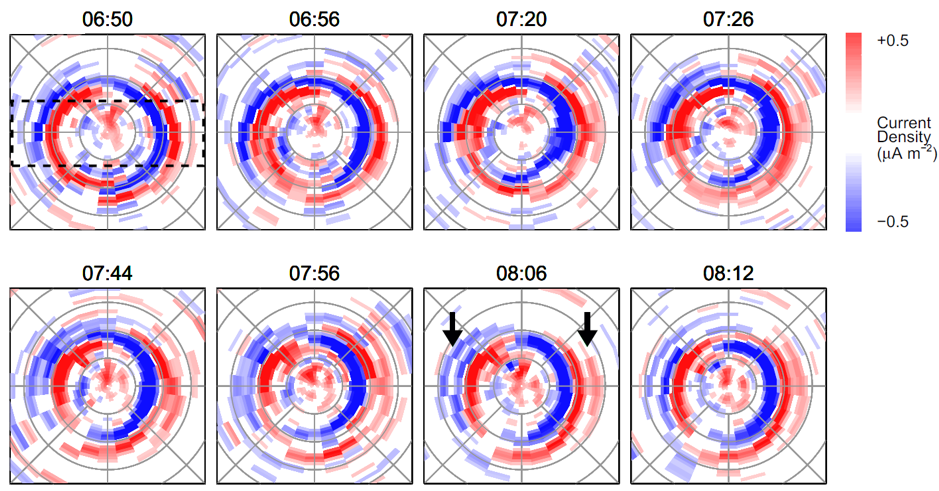MIST
Magnetosphere, Ionosphere and Solar-Terrestrial
Bifurcated Region 2 Field-Aligned Currents Associated With Substorms
By Harneet Sangha (University of Leicester)
The Earth’s field-aligned currents (FACs) are a key component of the solar wind-magnetosphere-ionosphere-atmosphere coupled system. They connect the magnetosphere to the ionosphere, forming two concentric rings of opposite polarity currents at dawn and dusk. The inner ring (Region 1, R1), at higher latitudes, connects to the magnetopause, whereas the lower latitude ring (Region 2, R2) connects to the inner magnetosphere. By studying them, we are able to observe the energy transfer throughout the system. They are highly variable, and the small scale changes can be difficult to detect. With the use of the Active Magnetosphere and Planetary Electrodynamics Response Experiment (AMPERE) (comprising 66-satellites that gather the data), we can observe these small scale, structures and variations in the FACs on short time scales.
In our work, we have observed a new phenomenon which we describe as the bifurcation of the R2 currents, and the formation of a new R2 current ring (seen in Figure 1). These current signatures appear to be associated with the substorm expansion phase, and during ongoing geomagnetic activity they appear to have a 1 hour quasi-periodicity. We suggest that these bifurcations are related fast, westward flows in the midlatitude ionosphere, known as subauroral polarization streams (SAPS).
We have proposed a new mechanism that describes the formation of these current bifurcations - consecutive particle injections into the inner magnetosphere during disturbed conditions cause separate partial ring currents to form, leading to the presence of distinct R2 current systems.

Figure 1: A series of polar projections of the AMPERE current density data for the Northern Hemisphere on 2 June 2011, from 06:50 to 08:12 UT. The colour scale for downward (blue) and upward (red) FACs saturate at ± 0.5 µA/m2. Concentric circles show colatitudes in steps of 10°, and 12 MLT (local noon) is presented at the top of the plots, with 06 MLT (dawn) on the right. The dashed box shows the dawn-dusk axis. At 06:50 UT a standard R1/R2 FAC distribution is evident. The locations of interest are highlighted in the first panel with arrows, where by 07:44 UT the R2 FACs bifurcate to form two concentric rings and can be seen between 20° and 30° colatitude.
For more information, please see the paper:
Sangha, H., Milan, S. E., Carter, J. A., Fogg, A. R., Anderson, B. J., Korth, H., & Paxton, L. J. (2020). Bifurcated Region 2 field‐aligned currents associated with substorms. Journal of Geophysical Research: Space Physics, 125, e2019JA027041. https://doi.org/10.1029/2019JA027041